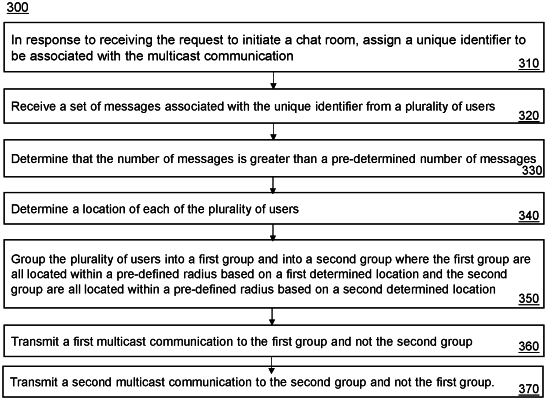| CPC H04L 12/1827 (2013.01) [H04L 12/1845 (2013.01); H04L 12/185 (2013.01); H04L 12/1877 (2013.01)] | 15 Claims |

|
1. A system for adaptively reducing bandwidth usage on a multicast computer network, the system comprising:
a centralized computer server that receives a request to initiate a chat room, associated with a news article or story, over a computer network based on a user selecting a chat button in response to the news article or story wherein selecting the chat button initiates the creation of the chat room; and
a non-transitory computer readable medium, comprising computer-executable instructions that perform a method when executed by the centralized computer server, the method comprising:
in response to receiving the request to initiate the chat room, assigning a unique identifier to be associated with the chat room;
receiving one or more messages associated with the unique identifier of the chat room from a plurality of users;
determining that the number of messages is greater than a pre-determined number of messages;
determining a location of each of the plurality of users utilizing the chat room;
grouping the plurality of users into a first group and into a second group where the first group are all located within a pre-defined radius based on a first determined location and the second group are all located within a pre-defined radius based on a second determined location;
transmitting a first multicast communication to the first group and not the second group;
transmitting a second multicast communication to the second group and not the first group;
receiving a second set of messages associated with the unique identifier from a second plurality of users associated with the second group;
determining that a number of users associated with the second group is greater than a pre-determined number of users;
regrouping the second group, including the second plurality of users, into a third group and a fourth group where the third group are all located within a second pre-defined radius based on a third determined location and the fourth group are all located within the second pre-defined radius based on a fourth determined location;
transmitting a third multicast communication to the first group and not the third group or the fourth group; and
transmitting a second multicast communication to the third group and not the first group or the fourth group.
|